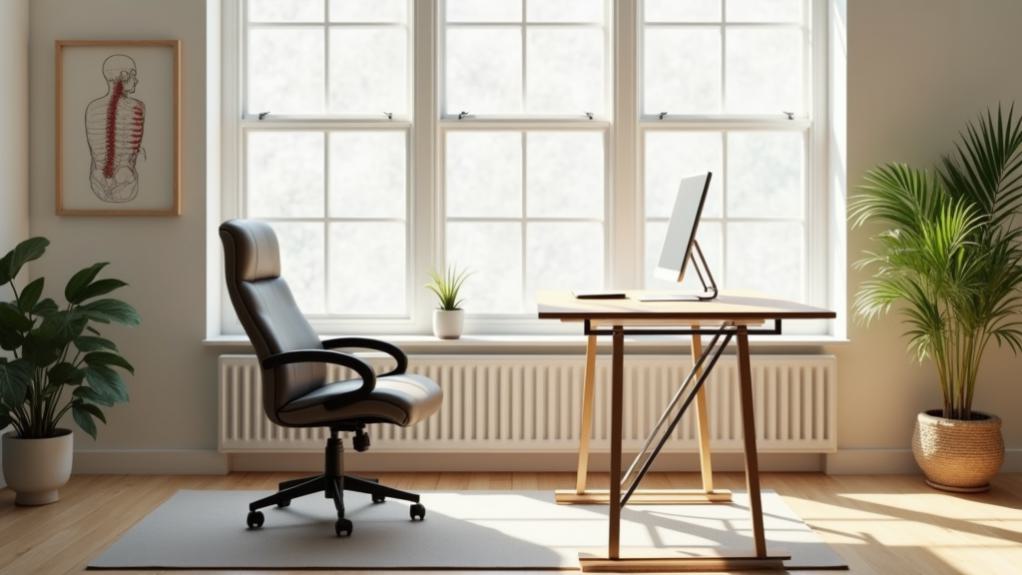To improve your posture and reduce back pain in midlife, focus on strengthening your core and upper back muscles with targeted exercises like resistance band rows and scapula squeezes. Make sure you take breaks every 30-60 minutes during prolonged sitting to reset your posture. Position your computer screen at eye level to minimize neck strain and consider using lumbar support for better alignment. Lowering your shoulder blades and visualizing a straight line from head to toe can also help. You’re just a few adjustments away from feeling markedly better, and there’s so much more you can explore to support your journey. In addition to targeted exercises for better posture, incorporating activities like yoga and Pilates into your routine can also help improve flexibility and strengthen the muscles that support your spine. These exercises can promote better alignment and reduce the likelihood of developing chronic back pain. Additionally, be mindful of your daily movements and posture, whether you’re sitting, standing, or lifting objects, to ensure that you’re not putting unnecessary strain on your back. By being proactive and dedicated to improving your posture, you can prevent future pain and discomfort, ultimately leading to a healthier and happier midlife.
Key Takeaways
- Engage in targeted exercises like scapula squeezes and resistance band rows to strengthen core and upper back muscles, improving posture and reducing pain.
- Take regular breaks every 30-60 minutes to reset your posture and alleviate muscle tension during prolonged sitting.
- Position your computer screen at eye level and use lumbar support to promote proper spinal alignment while seated.
- Seek professional guidance from a physical therapist for tailored exercises and strategies to address unique posture-related issues.
- Incorporate daily posture awareness practices, such as visualizing alignment and performing shoulder blade squeezes, to foster better habits.
Understanding Posture Improvement
When it comes to understanding posture improvement, it’s important to recognize that long-standing issues can still be addressed effectively. Regardless of your age, you can make noticeable changes by engaging in targeted activities aimed at strengthening your core muscles and enhancing your overall posture.
Consider incorporating exercises specifically designed for posture improvement, such as physical therapy routines that focus on your back and shoulder alignment. By committing to these exercises consistently, like scapula squeezes, you’ll not only improve your posture but also reduce back pain over time.
Awareness of your daily habits, especially with prolonged computer and smartphone use, is vital. Identifying these behaviors can help you take corrective action and promote better posture.
With dedicated effort and practice, you can expect visible improvements within six to twelve weeks. The key lies in staying committed to the exercises and being mindful of your posture throughout the day.
Common Causes of Poor Posture
Poor posture often stems from a combination of modern habits and physical conditions that can easily go unnoticed in daily life. With prolonged computer use and smartphone engagement, you’re likely to develop a forward head position and rounded shoulders. Slouching while sitting or watching television can exacerbate your posture issues, leading to muscle imbalances that affect spinal alignment.
Improperly carrying heavy objects can strain your back and core muscles, which ultimately results in postural deviations over time. Additionally, weak core muscles can make you lean forward, compromising your overall posture and increasing the risk of back pain and other musculoskeletal problems. Conditions like osteoporosis can further contribute to poor posture, leading to structural changes in your spine.
Here’s a summary of common causes of poor posture:
| Causes of Poor Posture | Effects on Muscles and Back Pain |
|---|---|
| Prolonged computer/smartphone use | Forward head, rounded shoulders |
| Slouching during sedentary activities | Muscle imbalances, spinal misalignment |
| Improper lifting of heavy objects | Strain on back and core muscles |
| Weak core muscles | Increased risk of postural issues |
Recognizing these factors is essential for addressing your posture effectively.
Consequences of Bad Posture

Bad posture can lead to a variety of serious consequences that impact your overall well-being. When you neglect your posture, you might experience more than just temporary discomfort. Over time, the effects can accumulate, greatly affecting your quality of life.
Here are some common consequences of bad posture:
- Back and neck pain: Poor alignment places undue stress on your spine, leading to chronic pain.
- Increased risk of falls: A forward shift in your center of gravity can make you more prone to falls, particularly if you’re already facing balance challenges.
- Breathing difficulties: Compressed lungs due to slouched posture can hinder your ability to breathe deeply, affecting your energy levels.
- Exacerbation of existing conditions: Chronic poor posture can worsen issues like arthritis or osteoporosis, complicating your musculoskeletal health.
Being aware of your posture is essential, as many people don’t realize the negative impacts until they experience great discomfort.
By recognizing these consequences, you can take steps to improve your posture and alleviate associated back and neck pain.
Effective Techniques for Posture Enhancement
To enhance your posture, focus on strengthening your upper back muscles through targeted exercises like scapula squeezes and resistance band rows.
Practicing daily posture awareness, such as visualizing proper alignment, can make a significant difference in how you carry yourself throughout the day.
Strengthening Upper Back Muscles
Strengthening your upper back muscles is vital for counteracting the negative effects of a sedentary lifestyle, which often leads to slouching and a forward head position.
When you actively engage your upper back, comprising muscles like the rhomboids and trapezius, you can markedly improve your posture and reduce back pain.
Here are some effective exercises to incorporate into your routine:
- Resistance Band Rows: These help target your upper back and enhance shoulder strength.
- Scapula Squeezes: Simple yet effective for promoting proper alignment and posture.
- Modified Planks: Strengthen your core stability, essential for maintaining an upright posture.
- Back Extensions: These bolster your back muscles and can alleviate discomfort.
Additionally, incorporating upper body stretches, such as chest openers, can relieve tightness in the chest and shoulders, supporting better posture overall.
With consistent practice of these exercises, you may notice improvements in your posture and a decrease in back pain within just six to twelve weeks.
Daily Posture Awareness Practices
Your daily posture habits play an essential role in maintaining a healthy spine and reducing discomfort. By incorporating simple practices into your routine, you can markedly improve your posture and alleviate back pain.
Consider visualizing a straight line from your head to your toes, which promotes proper alignment. Take breaks every 30-60 minutes to stand, stretch, and reset your posture, especially during prolonged sitting. Use a rolled towel or lumbar support to encourage an upright posture and reduce strain on your back. Additionally, position your computer screen at eye level to minimize neck strain.
Regularly practicing shoulder blade squeezes strengthens your back muscles and counters the effects of slouching.
Here’s a quick reference table to keep in mind:
| Practice | Benefit | Frequency |
|---|---|---|
| Visualize Alignment | Enhances awareness | Throughout the day |
| Take Stretch Breaks | Reduces forward lean | Every 30-60 minutes |
| Shoulder Blade Squeezes | Strengthens back muscles | Daily |
Practical Tips for Better Alignment

Achieving better alignment is essential for reducing back pain, especially during midlife when posture often deteriorates. Implementing practical strategies in your daily routine can greatly enhance your posture and alleviate discomfort.
Here are some tips to help you:
- Take regular breaks every 30-60 minutes during prolonged sitting to relieve forward posture and reduce back strain.
- Position your computer screen at eye level to minimize neck strain and encourage proper spinal alignment while working.
- Use a rolled towel or lumbar support while seated to promote an upright posture and support your lower back curvature.
- Engage in exercises that strengthen your core and back muscles, such as modified planks and resistance band rows, at least 2-3 times a week to enhance alignment.
Incorporating these strategies into your daily life not only fosters better posture but also helps mitigate back pain.
Remember, maintaining an upright alignment is a gradual process, and with consistent effort, you’ll likely notice improvements in your comfort and overall well-being.
Prioritize these adjustments, and you’ll be on your way to a healthier back!
Importance of Professional Guidance
Professional guidance plays an essential role in addressing posture-related issues, especially as you navigate midlife challenges. Seeking help from a physical therapist can be a game changer if you’re dealing with chronic back pain.
These trained professionals assess your posture and movement patterns, identifying specific weaknesses and imbalances contributing to discomfort. This personalized approach allows them to develop tailored exercise plans that target your unique needs.
Regular consultations with a physical therapist can help you monitor your progress and adjust your treatment plan as necessary. This is particularly important if you have underlying conditions like osteoporosis, which can affect your posture.
Additionally, engaging with professionals enhances your understanding of proper body mechanics during daily activities, greatly reducing your risk of injury.
Accessing advanced techniques, such as manual therapy or specialized equipment, can provide additional support in achieving better posture and alleviating back pain.
With professional guidance, you not only work on improving your posture but also gain valuable insights into maintaining it long-term. Embracing this support can empower you to take control of your posture and overall well-being as you move through midlife.
Conclusion
In your journey toward better posture and reduced back pain, remember that small, mindful changes can lead to significant improvements. Embracing these techniques not only enhances your physical well-being but also elevates your overall quality of life. By prioritizing alignment and seeking professional guidance when needed, you’re investing in a healthier, more vibrant future. So, let’s celebrate each step you take toward comfort and confidence, making every day a little brighter and more aligned.
Join our list
Subscribe to our mailing list and get interesting stuff and updates to your email inbox.

